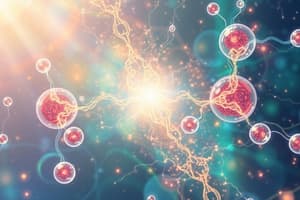Podcast
Questions and Answers
What is the primary function of positive feedback in biological systems?
What is the primary function of positive feedback in biological systems?
- To amplify a change in response to a stimulus (correct)
- To maintain equilibrium in the body
- To reduce the effects of stimuli
- To regulate temperature during cold exposure
What role does oxytocin play during childbirth?
What role does oxytocin play during childbirth?
- It promotes uterine contractions to increase pressure on the cervix (correct)
- It stimulates the release of glucagon
- It inhibits uterine contractions
- It regulates blood glucose levels
Which mechanism aids in regulating body temperature when it is too high?
Which mechanism aids in regulating body temperature when it is too high?
- Shivering to generate heat
- Sweating to promote evaporative cooling (correct)
- Increased metabolic rate to produce more heat
- Vasoconstriction to conserve heat
What triggers the release of insulin from the pancreas?
What triggers the release of insulin from the pancreas?
What is the normal range for human blood pH?
What is the normal range for human blood pH?
Which hormone is released when blood water levels are low?
Which hormone is released when blood water levels are low?
How does the body primarily respond to rising carbon dioxide levels?
How does the body primarily respond to rising carbon dioxide levels?
What is the function of buffers in the blood regarding pH balance?
What is the function of buffers in the blood regarding pH balance?
What is the primary purpose of homeostasis in organisms?
What is the primary purpose of homeostasis in organisms?
Which component of a homeostatic system detects changes in the internal environment?
Which component of a homeostatic system detects changes in the internal environment?
What role does the control center play in a homeostatic system?
What role does the control center play in a homeostatic system?
Which of the following best describes negative feedback mechanisms?
Which of the following best describes negative feedback mechanisms?
In thermoregulation, if body temperature increases, what is the sequence of responses initiated?
In thermoregulation, if body temperature increases, what is the sequence of responses initiated?
Which of the following examples illustrates the process of glucoregulation?
Which of the following examples illustrates the process of glucoregulation?
Which organ system is primarily involved in the control center function during homeostasis?
Which organ system is primarily involved in the control center function during homeostasis?
What might happen if homeostatic mechanisms fail?
What might happen if homeostatic mechanisms fail?
Flashcards are hidden until you start studying
Study Notes
### Homeostasis: Maintaining Internal Stability
- Definition: Homeostasis is the process of maintaining a stable internal environment within an organism despite external changes. This is crucial for survival.
- Importance: Homeostasis regulates vital factors like body temperature, blood pH, glucose levels, and water, ensuring cells function properly.
### Components of Homeostasis
- Receptors (Sensors): Detect changes in the internal environment (e.g., temperature sensors in the skin).
- Control Center (Brain or Endocrine System): Processes information from receptors and determines the appropriate response.
- Effectors: Carry out the response, often organs like muscles (shivering), glands (sweating), or kidneys (regulating water).
Feedback Mechanisms
- Negative Feedback: Counteracts changes to restore equilibrium, the most common type.
- Example: Thermoregulation: When body temperature rises, thermoreceptors send signals to the hypothalamus. The brain instructs sweat glands to release sweat for cooling and blood vessels to dilate for heat loss.
- Example: Glucoregulation: After a meal, the pancreas releases insulin, causing cells to absorb glucose and decrease blood sugar.
- Positive Feedback: Amplifies or reinforces a change, usually in situations where a rapid response is necessary.
- Example: Childbirth: The baby's head pressing against the cervix triggers the release of oxytocin, which intensifies contractions until delivery.
Factors Regulated by Homeostasis
- Body Temperature:
- Normal Range: Around 37°C (98.6°F) for humans.
- Mechanisms:
- Heat production: Shivering generates heat when the body is cold.
- Heat loss: Sweating and vasodilation (widening blood vessels) release excess heat.
- Blood Glucose Concentration:
- Normal Range: 70-100 mg/dL (fasting).
- Mechanisms:
- Insulin: Lowers blood glucose by facilitating glucose uptake into cells.
- Glucagon: Raises blood glucose by releasing stored glucose from the liver.
- Blood pH:
- Normal Range: Around 7.35-7.45 (slightly alkaline).
- Mechanisms:
- Buffers: Neutralize excess acids or bases in the blood.
- Breathing Rate: Controls CO₂ levels which influence pH.
- Water and Salt Balance (Osmoregulation):
- Mechanisms:
- Kidneys: Filter blood and adjust urine concentration.
- Antidiuretic Hormone (ADH): Promotes water reabsorption in the kidneys when water levels are low.
- Aldosterone: Regulates sodium and potassium balance, influencing blood volume and pressure.
- Mechanisms:
- Oxygen and Carbon Dioxide Levels:
- Mechanisms:
- Breathing Rate: Increases when CO₂ levels rise or oxygen levels fall.
- Hemoglobin: Transports oxygen and carbon dioxide in the blood.
- Mechanisms:
Thermoregulation (Temperature Control)
- Key Concept: Maintaining stable body temperature within a narrow range is crucial.
- Mechanisms:
- Radiation: Heat transfer through electromagnetic radiation.
- Conduction: Heat transfer through direct contact.
- Convection: Heat transfer through the movement of fluids.
- Evaporation: Heat loss through the conversion of liquid to gas (sweating).
Studying That Suits You
Use AI to generate personalized quizzes and flashcards to suit your learning preferences.




